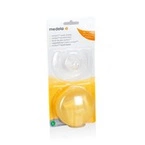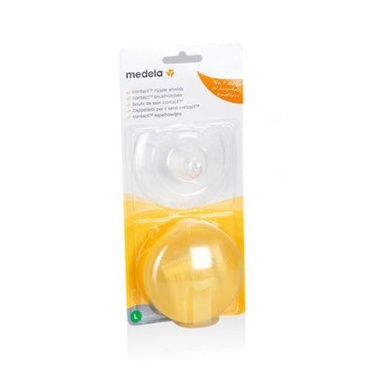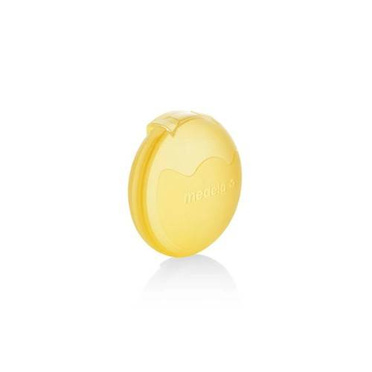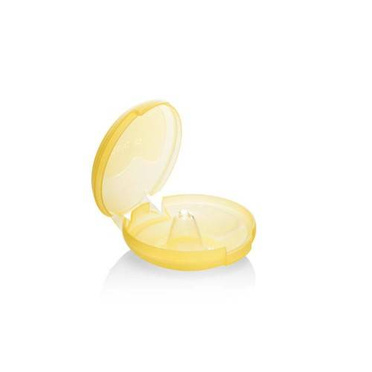- Medela Contact™ Nipple Shields enable breastfeeding when baby is difficult or painful to latch on, by protecting sore nipples and making it easier for your baby to latch on.

- Supports breastfeeding if your nipples are sore or your baby has difficulty latching on, or if you have flat or inverted nipples
- Protects sensitive, dry or cracked nipples during breastfeeding
- Transparent, exceptionally thin and soft silicone provides comfort to the mother's sensitive skin
- Safe and tasteless for children
- The shape ensures close contact between mother and child
- BPA free
What is a nipple shield?
A nipple shield is a thin, flexible piece of silicone that is placed over the nipple before feeding to protect it. The tip is perforated so that the baby can suckle the milk. Some mothers worry that the "barrier" separating them from their baby will affect the intimate experience of feeding, which is why Medela Contact™ nipple shields have a cutout to allow skin contact.
When to use nipple shields for nursing
Nipple covers (or nipple caps) are useful in three basic situations:
- For painful, cracked nipples or nipple pain.
- When the nipples are flat or inverted.
- If your baby has difficulty latching on to the breast and drinking milk.
A lactation consultant will help you determine if nipple shields are right for you, as well as provide assistance with other breastfeeding-related issues.
How to use nipple shields for nursing
After washing your hands with drinking water and drying them thoroughly, grasp the wings of the Contact™ nipple shield and place it in place. Wetting the nipple shield with drinking water will make it easier for it to stick to your skin. Detailed instructions on how to put on the Contact™ nipple shields are in the user manual. Nursing nipple shields should be comfortable and not constricting – Medela nipple shields are available in three sizes to suit your nipple type, and a fitting guide is also available. Remember to wash them after each use and disinfect them once a day – the easiest way to do this is to use microwave disinfection bags – details on washing and disinfecting are in the user manual. Contact™ nipple shields are sold with a convenient storage and carrying case.
Nipple pads for sore nipples
Sore or cracked nipples can have a variety of causes, so it’s important to identify the root cause before deciding what to do next. If you have sore nipples, you can first try hydrogel pads or nipple shields and seek help from a lactation consultant . If that doesn’t help, Contact™ Nipple Shields can help protect your nipples while still allowing you to breastfeed – they’re made from very thin, soft silicone and are gentle on even sore, dry or cracked skin.
Pads for flat or inverted nipples
If you have flat or inverted nipples, your baby may have trouble latching on, especially when they are small – but that doesn’t mean you can’t breastfeed! Inverted or flat nipples often don’t reach the roof of your baby’s mouth, so sucking doesn’t always happen. Contact™ Nipple Shields can help solve this problem. Because they are tasteless, your baby shouldn’t be able to tell the difference when using them.
How to help your baby latch on
As mentioned above, nipple shields can help your baby to latch on to the nipple. Your lactation consultant will help you determine if your baby is latching on well when using a shield. You should also monitor your baby’s weight gain to make sure they are getting enough milk. Nipple shields are a short-term solution – over time, as your baby gains the strength to suck and becomes accustomed to breastfeeding, you can start to wean them off nipple shields.








 Quick and convenient financing for major online purchases
Quick and convenient financing for major online purchases